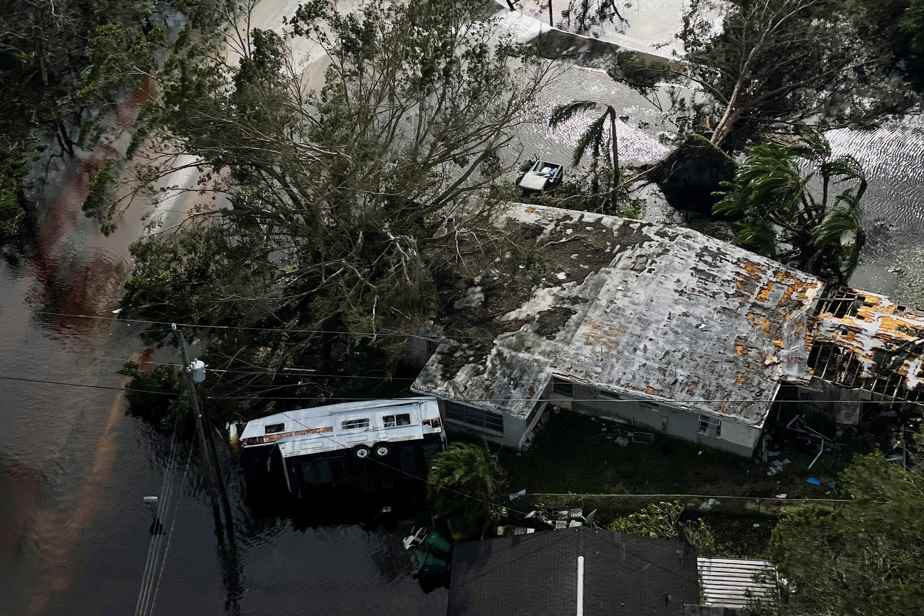(Fort Myers) Devastated cities, millions of people without electricity, but above all a human toll that could be “substantial”: Florida just began Thursday to take the measure of the considerable damage caused by the hurricane Ian.
Posted at 6:44 a.m.
Updated at 6:05 p.m.
Downgraded to a tropical storm after passing over land, Ian strengthened again to the point of being recategorized as a hurricane by the National Hurricane Center (NHC). Ian was heading late Thursday afternoon towards North Carolina, South Carolina, and Georgia, in the southern United States.
While the images of streets transformed into channels of murky water multiplied, of boats thrown to the ground like simple toys, of shattered houses, the latest balance sheet in Florida reported at least eight dead.

PHOTO BY BRYAN R. SMITH, AGENCE FRANCE-PRESSE
Andrea Barrios and her daughter Hannah look at the demolished roof of her father’s house in Charlotte Harbor, Florida.
“This could be the deadliest hurricane in Florida history,” US President Joe Biden said during a visit to the offices of the federal agency that fights against natural disasters, Fema.
” Numbers […] are not yet clear, but we are receiving initial reports of human losses which could be substantial, ”he added, saying he wanted to go to the southern state as soon as possible, but also to American territory. Puerto Rico, an island recently damaged by Hurricane Fiona.
night of anguish
An official in Charlotte County, West Florida, confirmed to CNN the death of six people, without giving further details.
A spokesperson for Volusia County, on the east coast, announced that it had recorded “the first death linked to the hurricane Ian “, a 72-year-old man, “went out to empty his pool during the storm”.

PHOTO DOUGLAS R. CLIFFORD, TAMPA BAY TIMES/ASSOCIATED PRESS
A section of road was demolished in Sanibel, Florida during the hurricane.
An official in Osceola County, in the east-central part of the state, told CNN of the death of a resident of a nursing home.
At the same time, the search continued to find 18 passengers of a migrant boat which capsized on Wednesday near the archipelago of the Keys, nine others having been rescued.
After a night of anguish, the inhabitants began the inventory of fixtures Thursday.
In the village of Iona, Ronnie Sutton, who has still not been able to return home, said he was convinced that the water had destroyed everything.
“It’s awful. I guess that’s the price you pay when you live at sea level. Sometimes it backfires on you,” he lamented.
In Fort Myers, flooding swamped some boats, pushing others into downtown streets.
“These were terrifying noises, with debris flying everywhere, the doors in the air,” testified a resident who witnessed the destruction, Tom Johnson.

PHOTO MARCO BELLO, REUTERS
“We have never seen floods like this,” said Republican Florida Governor Ron DeSantis.
“Some of these areas, Cape Coral, the city of Fort Myers, were really flooded and really devastated by this storm,” he continued, calling the damage “historic.”
Without electricity
Ian made landfall Wednesday afternoon as a Category 4 hurricane (on a scale of 5) in southwest Florida, before continuing to track across the state, bringing high winds and torrential rains .
Thursday afternoon, more than 2.6 million homes or businesses remained without electricity, out of a total of 11 million, according to the specialized site PowerOutage.

PHOTO ASSOCIATED PRESS
Punta Gorda, a small coastal town located in the path of the hurricane, woke up without power.
Ian uprooted some trees and knocked down utility poles and traffic signs. Its rains flooded the streets of the marina, where the water still reached the calves Thursday morning.
“It was incessant, it was constantly blowing above our heads. You could hear the metal banging against the building. It was dark. We didn’t know what was going on outside,” said resident Joe Ketcham.
Faced with the extent of the damage, Joe Biden had declared a state of major natural disaster on Thursday morning, a decision making it possible to release additional federal funds for the affected regions.
As the surface of the oceans warms, the frequency of the most intense hurricanes, with stronger winds and greater precipitation, increases, but not the total number of hurricanes.
